|
( See the remarkable models of the First Fleet)
Captain James Cook had sighted the east coast of Australia in 1770, and then landed at Botany Bay. On his return to England, he had recommended this site as a suitable place to establish a settlement in this new and far off land.
With the housing of many convicted felons presenting problems in England, his recommendation came to be considered, and it was decided to now establish a penal colony in Australia.
To this end, a fleet of 11 ships was gathered together to make the long journey from Portsmouth to Botany Bay. They consisted of two warships, six convict transports, and three store or supply ships.
These were:
HMS Sirius, flagship of Captain John Hunter R.N. a vessel of 540 tons, built at Whitby in 1780 and then named Berwick, destined for the East Indies route, had been badly burned in a fire, rebuilt by the Navy in 1786 to be given her present name.
HMS Supply, a much smaller ship of but 150 tons and a crew of 50, under the command of Captain Henery Ball R.N. This ship was probably the fastest in the First Fleet.
Alexander, the largest convict transport, was a 450 ton ship with Duncan Sin Clare her Master, and carrying 195 male convicts.
Scarborough, of 430 tons, with 208 male convicts and John Marshal was the Master.
Prince of Wales, John Mason the Master of this 350 ton convict transport, her cargo, 49 female convicts and a single male, one wonders how it came about that a sole male had so many female convict companions, and if he was much in demand during this long voyage.
Lady Penrhyn of 330 tons, her Master, William server, with 101 female prisoners.
Charlotte, Thomas Gilbert as Master of this 335 ton convict transport with 88 males convicts and 20 females.
Friendship, the last of the convict transports, was indeed the smallest vessel of the six transports, being a 274 ton vessel with Francis Walton as Master, and carrying some 76 male convicts and 21 females.
In all, we find these six transports had on board, a total of 568 male and 191 female convicts, all bound with their military escort of 191 Marines under 19 Officers, to start a new life, thousands of miles away from the land of their birth, off virtually to found a new nation called Australia.
The three store or supply ships were:
Borderdale, 375 tons and Thomas Hobson her Master.
Golden Grove, also of 375 tons, her commander only seems to be listed anywhere as Master Sharpe.
Fishburn, made up the last of the supply ships and the First Fleet, she had a tonnage of 378, and her Master was Robert Brown.
First Fleet sails.
Sails were set, and the First Fleet bade goodbye to England as they sailed from Portsmouth on the 13th. of May in 1787. In June they made port at Tenerife, then to zig across the Atlantic Ocean to Rio de Janeiro, to arrive there in August, now to zag back across the South Atlantic to Cape Town, on arrival there in October, to reprovision, and prepare for the long flog across the southern part of the Indian Ocean, around southern Australia to turn north and make for Botany Bay.
The First Fleet Arrives at Botany Bay.
Between the 18th. and the 20th. of January 1788, the First Fleet ships straggled into Botany Bay to anchor, their long voyage almost over. Not withstanding Cook's recommendation that this spot was suitable for establishing a settlement in Australia, Hunter found that there was not a good enough supply of fresh water at Botany Bay, and he ordered the Fleet to move on to Port Jackson.
Thus the new Colony all moved, to found my country AUSTRALIA on the 26th. of January
1788.
Transportation over the years of 1788 - 1850.
The transportation of convicts to the Colony of Australia continued until 1850. Over the long period of 1788 - 1850, some 162,000 convicts made the perilious journey via sailing ship from England to Australia, and the amazing number of ships needed to carry them all was 806.
Relatively, these sailing ships were quite tiny, and whenever these days I see a replica of one of them, I am impressed by the skill and endurance of those ship's Captains and their intrepid crews who brought so many convicts to their new home, to found a now prospering but still young new nation.
| 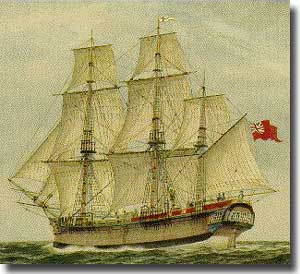
HMS Sirius, the main Naval ship with the First Fleet, under Captain John Hunter RN.
Had been built in 1780 as Berwick for the East Indies run, badly burned in a fire, and rebuilt by Navy, renamed Sirius, finally wrecked off Norfolk Island on the 14th. of April 1790.
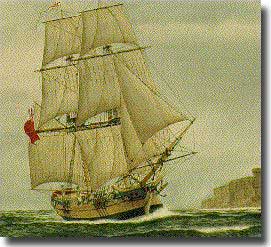
HMS Supply, smallest ship in First Fleet and the fastest, acted as a fleet tender.
On her return to England, renamed Thomas and Nancy, finished her life as a coal carrier.

Friendship, one of 6 Convict transports, and the smallest of them.
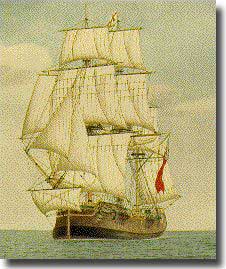
Convict Transport Alexander

Charlotte, one of 6 convict transports.
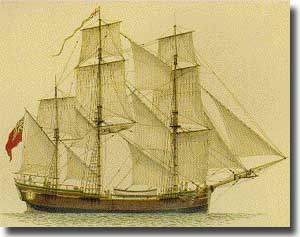
Scarborough, Convict Transport. On her return to England, sailed again with convicts in the Second Fleet.
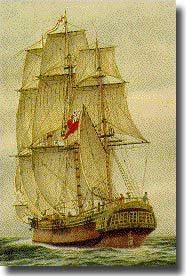
Prince of Wales, Convict Transport, had but 1 male convict amongst her 49 female convicts.
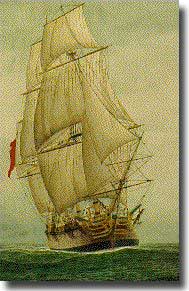
Lady Penrhyn, Convict Transport.
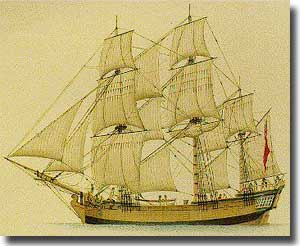
Golden Grove, storeship. Carried the first Chaplain Richard Johnson and his wife.
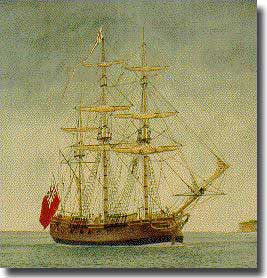
Fishburn, one of 3 store ships.
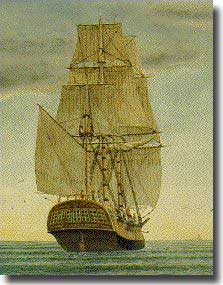
Borrowdale, one of the 3 store ships.
|